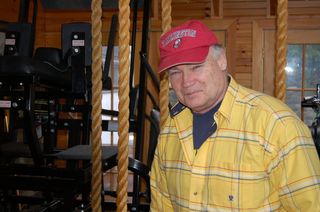By Wayne L. Westcott, PhD*
In the area of strength training, there are as many workout routines as there are body builders, weight lifters, power athletes, and strength coaches. Every strength expert seems to possess the perfect training program for maximizing muscle development.
Fortunately, several respected professional associations have come to consensus on recommended training procedures for safe, sensible, and successful strength exercise. These include the American College of Sports Medicine, the American Council on Exercise, and the YMCA of the USA. The training guidelines, which include the following, are designed for average adults who desire a higher level of strength fitness.
1. Training Exercises: Eight to twelve strength exercises that address all of the major muscle groups.
2. Training Frequency: Two to three nonconsecutive training sessions per week.
3. Training Sets: One or more sets of each exercise.
4. Training Resistance: Approximately 70 to 80 percent of maximum resistance.
5. Training Repetitions: Approximately eight to twelve controlled repetitions.
6. Training Progression: Approximately 5 percent increase resistance whenever 12 controlled repetitions are completed.
7. Training Speed: Slow to moderate movement speed–for example, two seconds lifting and four seconds lowering.
8. Training Range: Whenever possible, full range of joint movement.
These basic exercise procedures have proven to be an effective and efficient means for developing muscle strength and mass. Studies with youth, adults, and seniors have shown significant increases in muscle strength (about 70 percent) and muscle mass (about 3 pounds) after eight weeks of training in the recommended manner. While these improvements continue for several months, progress comes more slowly and eventually begins to plateau.

Strength Plateaus
Strength plateaus are an inevitable part of the muscle-building process. At some point, the training effort that previously stimulated positive muscle adaptations is no longer productive. This does not mean that further strength development is impossible, but it does indicate a need for program changes.
Most people recognize that, to overcome a strength plateau, they must train a little harder. However, many exercisers confuse working harder with working longer. That is, they increase their exercise duration rather than their exercise intensity. For example, instead of performing one set of each exercise, they jump to two or three sets of each exercise. While this certainly increases the work volume, it has little impact on the work intensity.
Let’s say that John typically performs 10 leg extensions with 150 pounds, which is 75 percent of his maximum resistance. As John’s quadriceps muscles fatigue, his momentary strength decreases on a repetition-by-repetition basis. By his 10th repetition John has reduced his starting strength by 25 percent, and he can no longer lift 150 pounds. That is, when John’s quadriceps muscles fatigue below 75 percent of maximum strength, he can no longer lift 75 percent of maximum resistance.
If John chooses to perform a second set of leg extensions, he will clearly perform a greater work volume. He is unlikely to achieve a greater work intensity, however, by completing additional sets of leg extensions. This is due to the fact that each set of 150-pound leg extensions fatigues the same 25 percent of John’s quadriceps muscle fibers. Because the same muscle fibers are activated in the same recruitment pattern, there is little response difference between the first and last set of a given exercise.

High-Intensity Strength Training
The primary intent of high-intensity strength training is to fatigue additional muscle fibers during a more demanding exercise set. One means of achieving this objective is to reduce the exercise resistance at the point of muscle failure. For example, when John can complete no more leg extensions with 150 pounds, he may immediately reduce the resistance to 130 pounds and perform a few more repetitions. By so doing, he may fatigue more muscle fibers and provide a greater strength-building stimulus. With this technique, called breakdown training, John experiences two levels of muscle failure and fatigues 35 percent of his quadriceps muscle fibers.

Research on Breakdown Training
In a recent research study, we compared standard training with breakdown training. Forty-five adults (men and women between 25 and 54 years of age) and 15 seniors (men and women between 55 and 84 years of age) participated in this study.
During the first four weeks all 60 subjects trained in the standard manner (one set of 8-12 repetitions per exercise). During the second four weeks half of the subjects continued to perform one set of 8-12 repetitions per exercise. The other half performed one set of 8-12 repetitions, then immediately reduced the weightload by 10 pounds and completed as many additional repetitions as possible (typically 2-4 breakdown reps with the lighter resistance).
The subjects who performed breakdown training experienced significantly greater strength gains than the subjects who trained in the standard manner. The high-intensity-trained adults gained 39 percent more strength and the high-intensity-trained seniors gained 100 percent more strength.
Given these findings, it would appear that breakdown training is more effective than standard training for developing muscle strength. It is assumed that the breakdown repetitions produced a greater strength-building stimulus. It is also likely, however, that the breakdown repetitions encouraged greater training effort. That is, the subjects who performed breakdown repetitions probably pushed themselves harder after realizing that the standard training set did not fully fatigue their muscles. This learning effect may explain the large difference in strength development between the two senior groups.
Assisted Training
Another means of increasing the training intensity is assisted training. Like breakdown training, the resistance is reduced at the completion of a standard exercise set to enable a few additional repetitions. Instead of changing the weightload, however, a trainer gives just enough manual assistance to complete another repetition.
Because we can lower more resistance (negative muscle contraction) than we can lift (positive muscle contraction), the assistance is limited to the lifting movements. The trainee handles the full resistance on the lowering movements.
Pre-Exhaustion Training
Pre-exhaustion training is also designed to fatigue more muscle fibers than standard training. With this high-intensity technique, you complete two successive exercise sets for the same muscle group. The first set is typically performed with a rotary exercise that fatigues the target muscle group. The second set is conducted with a linear exercise that involves both the fatigued target muscle group and a fresh muscle group.
For example, you may do a set of chest flies to pre-exhaust the pectoralis major muscles. At the point of failure, you may immediately perform a set of chest presses using both the fatigued pectoralis major muscles and the fresh triceps muscles.
By incorporating different movement patterns and fresh muscles, pre-exhaustion training produces greater fatigue in the target muscle group. Other effective pre-exhaustion combinations include lateral raises followed by overhead presses for the deltoid muscles, pullovers followed by pulldowns for the latissimus dorsi muscles, arm curls followed by chin-ups for the biceps muscles, arm extensions followed by dips for the triceps muscles, and leg extensions followed by leg presses for the quadriceps muscles.

Conclusion
Our study with adults and seniors demonstrated significantly more strength development with breakdown training than with standard training. Although not researched, experience indicates that assisted training and pre-exhaustion training are also effective means of producing more muscle fiber involvement and promoting greater strength gains. In addition to the physiological adaptations associated with high-intensity strength exercise, there would appear to be psychological changes as well. That is, people who practice high-intensity techniques are likely to train harder than those who have not exercised in this manner.
Because of the greater effort required by high-intensity strength exercise, it should not be overdone. A single breakdown set, a few assisted repetitions, and an occasional pre-exhaustion workout will be sufficient. Most important, be sure to perform every repetition in standard and high-intensity exercise with proper technique and controlled movement speed
*Wayne L. Westcott, Ph.D., is fitness research director at the South Shore YMCA in Quincy, MA. Dr. Westcott has written the Muscular Strength And Endurance chapter for the ACE Personal Trainer Manual and has authored several textbooks on strength training.
TAKU’s NOTE: This week I offer yet another excellent article from my friend and mentor Dr Wayne Westcott.
Filed under: Coach's Corner, Hybrid Advisors | Tagged: Athletics, H.I.T., Recovery, Training, Variety, workout | Leave a comment »















































